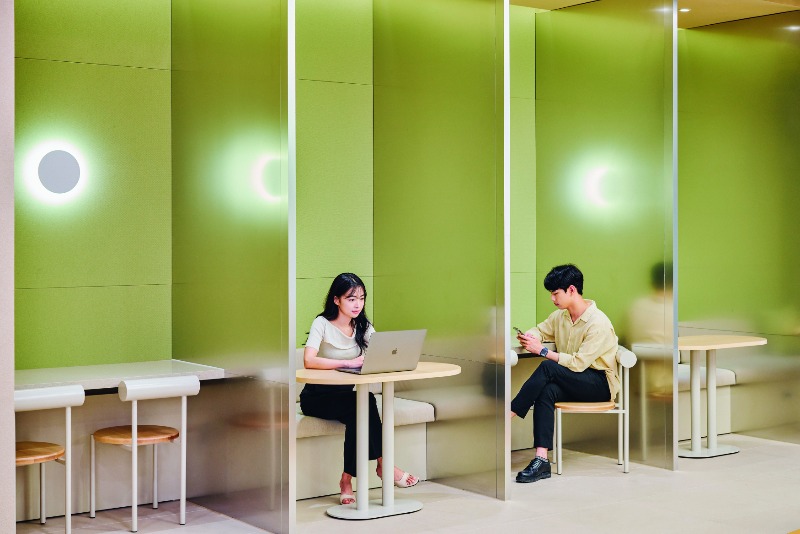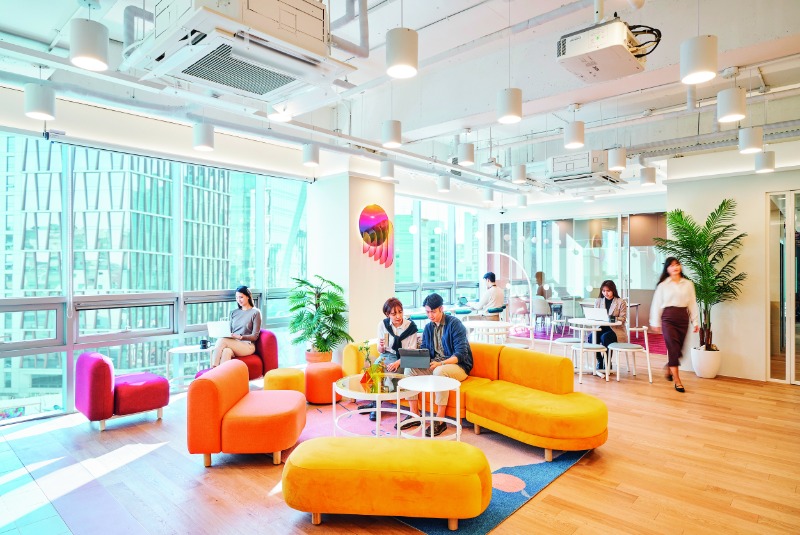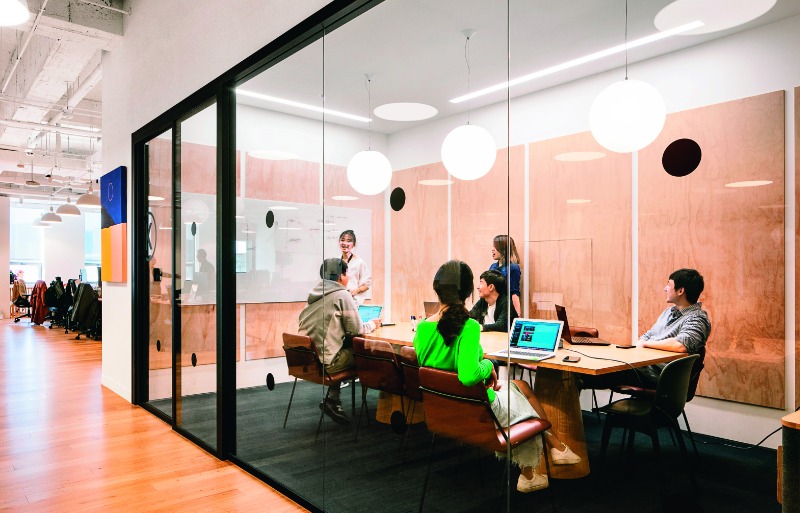For a mounting number of Koreans, leaving home to work in a traditional office setting is no longer the daily routine. At any hour of the day, many now head for coworking places, where they share space with other individuals whom they may not even know. A global pandemic, as well as the digital age and pursuit of cost efficiency, has boosted the adoption of these shared spaces.
“I commuted to work in another area of Seoul over the past year. But I decided to rent a shared office space in this new building because it’s closer to my home.” “It’s really convenient because the office is just a one-minute walk from the subway station, and we can use a seminar room and lounge.” “It was good for us to decide to move here because we can have a working environment, as if we were in a large company.”
Judging by comments on Korean online communities, the use of coworking spaces – working spaces located outside a traditional office setting – has overwhelming approval. What started and gathered steam before the COVID pandemic has seemingly pushed ahead past the point of no return for many companies and office workers.
Coworking is categorized as the use of shared workspaces and offices. These differ from the no-frills open workspaces that anyone can use.
Shared workspaces may have meeting rooms, a lounge area and kitchenettes. A shared office typically involves a company with spare offices renting those spaces to unrelated companies or collaborating with a coworking operator to find tenants. Coworking became increasingly popular after the global recession of 2008-2009, when the concept of a sharing economy of goods and services emerged. The concept morphed to allow individuals, small groups and startups to share vacant office spaces at a fraction of the cost of having their own exclusive spaces. Nowadays, operators of shared workspaces compete fiercely. They rent floors of high-rise buildings, partition the spaces and push hard for renters, touting special discounts or premium workspace environments. Many users are individuals who don’t need a permanent office, such as digital nomads, consultants, freelancers or solopreneurs. They may not want to work from home every day or may simply feel more productive in a professional environment. Being in a shared workspace also affords the opportunity to network, forming new business connections and building synergy working alongside like-minded people.

Most shared offices have enclosed rooms and an area with unassigned tables. The atmosphere is cozy like a café, but without the bustle. The lack of distraction and noise helps users focus on their tasks.
© FASTFIVE FIVESPOT Hapjeong
RACE FOR SPACE
In Korea, coworking spaces began growing rapidly in the mid-2010s. The acceleration was propelled by FastFive, Korea’s first coworking space operator, founded in 2015, and Spark Plus, another domestic operator established in 2016. In addition, WeWork, a U.S. coworking space operator, opened its first branch in Korea in 2016.
With public attention heightened, the number of shared workspaces in Seoul soared from a mere 20 in 2010 to more than 100 in 2016 and up to 220 in July 2019. Major business districts such as Gangnam have experienced the boom. Corporations moving partly or entirely from these districts to the suburbsa tempting supply of empty spaces near urban transportation hubs. In fact, the corporations themselves may abandon their traditional office setting altogether and opt for a less expensive shared office space arrangement.
The total area of all shared workspaces in the capital increased from 50,000 sq. meters to a whopping 600,000 sq. meters during the same period, according to the research institute of KB Financial Group. FastFive’s website reported 38 branches across the country as of December 2021, and a total of 13,290 firms, ranging from startups to conglomerates, using its coworking space services. The company also expects that nearly 90 percent of its customers will renew their contracts.

A space in a shared office can be rented on a monthly basis. The set-up is so simple and convenient that customers can begin using their rented space immediately. When the contract expires, renewal is easy, with adjustments as needed.
© FASTFIVE Sinsa
EVERYDAY LOW PRICE
By far, the affordability of sharing a workspace or office is the main driver for users. Small businesses and startups especially benefit. They can avoid burning through cash, buying furniture and office equipment, and can move easily if they outgrow their space.
Naturally, operators of coworking spaces emphasize cost savings. On its website, FastFive tries to attract the attention of potential users by claiming, “We guarantee that you can reduce your initial investment costs and fixed expenses. Even if your firm is small, you can have an office in a high-rise building near a subway station.”
Flexible office spaces or lease terms are also major contributing factors in the surging popularity of coworking spaces. Leases are available on a minimum monthly basis. This allows for an easy move to a larger or smaller space without being tied down to long-term contracts and hefty rent deposits.
Users of coworking spaces ty pically have 24-hour access to their rented area, another significant boon for companies that adopt flexible work arrangements. Some work-from-home or work-from-anywhere employees may prove to be less productive when seated at their home kitchen table. A coworking space gives them a better chance to thrive.

Several factors determine the rental price, including the number of users and the number of tables needed and whether the rented space has a window. But in most cases, essential office supplies, printing, coffee and snacks are included in the price.
© WEWORK KOREA
OUTLOOK
The coronavirus pandemic intensified the movement toward coworking spaces around the world. Korea is no exception. It is hard to imagine the work environment will return to pre-pandemic levels when legions of office workers commuted to and from work at fixed hours. More and more companies have adopted flexible work schedules, helping working parents and tapping into the time slots when individual employees are most productive. The internet has without doubt transformed the business world dramatically. Today, a little capital, a great idea and internet access are all that is needed to start a one-person company or a startup with a small group of cohorts. Coworking spaces help these ventures avoid the headache of searching for an affordable location and the costs of setting it up. Even established companies can take advantage of the new paradigm.
A marketing firm, for example, doesn’t need its digital marketing team members at fixed desks. They can work from home and meet at a workspace, which allows the company to scale down while boosting profits. Less certain is the business model of coworking space operators. Ironically, they are tied down to the very arrangements that they help their customers avoid. They must fill the space that they have either leased on long-term contracts or purchased outright. Yet the fierce competition in the market keeps rental prices low and short-term contracts mean their monthly revenue may be uneven. Meanwhile, more must be spent on services and perks for renters to avoid steady flight and attract new customers.
Operators will have to find the proper formula for their business. Should they aim for maximum daily occupancy by individuals, foregoing dedicated desks? Or should they offer a fully furnished communal arrangement that encourages small-group collaboration?
Kim Dong-hwan Reporter, The Segye Times